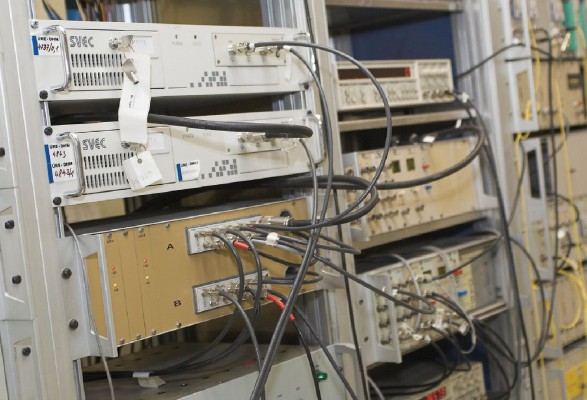Time interval measurement based on excitation of a surface acoustic wave filter
Year: 2006
Petr Pánek, Ph.D.
Time measurement plays a key role in modern technologies, since the measurement of many quantities is transferred to the measurement of time interval. Current methods of time measurement allow to achieve a very high resolution of the interpolation between the time marks of the reference time scale. The measured event triggers a suitable deterministic process which is then observed in the instants of time marks. Based on these observations, one can determine the instant of the event. The key problem in the design of a time interpolator is creating a mechanism that would generate a perfectly predictable process.
We have developed and theoretically analyzed a new method for time-interval measurement [1,2,3] that makes use of a time interpolator based on a surface acoustic wave (SAW) transversal filter. This filter when excited by a short pulse generates a signal of finite length, whose spectrum is concentrated in a limited band. It follows from the sampling theorem that if this signal is sampled with an appropriate frequency, it can be exactly reconstructed from a finite number of samples. By comparing two reconstructed filter responses, we can determine the time interval between the two exciting pulses. The developed method provides excellent accuracy in relation to the period of reference time marks. In first experiments we have achieved an accuracy of 25 ps rms at a clock frequency of 16 MHz. Our analysis has shown that by employing the state-of-the-art components currently used in mobile communications, we can expect an accuracy on the order of 0.1 ps.
- Pánek, P.: Error Analysis and Bounds in Time Delay Estimation. IEEE Transactions on Signal Processing (v tisku, 2006)
- Pánek, P.: Time Interval Measurement Based on SAW Filter Excitation. IEEE Transactions on Instrumentation and Measurement (zasláno k publikaci)
- Pánek, P.: "Random Errors in Time Interval Measurement Based on SAW Filter Excitation. IEEE Transactions on Instrumentation and Measurement (zasláno k publikaci).


